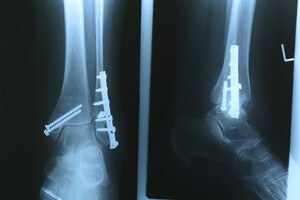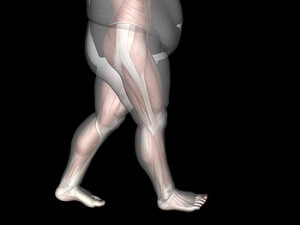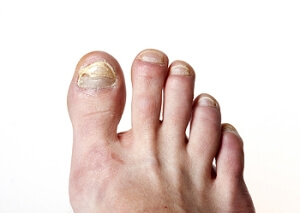BLOG

Stress Fractures Develop Gradually
 A stress fracture is often referred to as a hairline fracture, and typically develops gradually. It occurs as a result of a weakened bone in the foot, and this may happen from frequently participating in walking and running activities. Additionally, it can become a common issue if the running surface changes, or possibly from starting to train too soon after an injury occurs. Some of the symptoms that are associated with this condition can include swelling on or around the affected area, and experiencing pain while walking. Effective treatment can begin by refraining from the activity that caused the injury, and elevating the affected foot to help reduce existing swelling. If you have a stress fracture, please schedule an appointment with a podiatrist who can help you with exploring your treatment options.
A stress fracture is often referred to as a hairline fracture, and typically develops gradually. It occurs as a result of a weakened bone in the foot, and this may happen from frequently participating in walking and running activities. Additionally, it can become a common issue if the running surface changes, or possibly from starting to train too soon after an injury occurs. Some of the symptoms that are associated with this condition can include swelling on or around the affected area, and experiencing pain while walking. Effective treatment can begin by refraining from the activity that caused the injury, and elevating the affected foot to help reduce existing swelling. If you have a stress fracture, please schedule an appointment with a podiatrist who can help you with exploring your treatment options.
Stress fractures occur when there is a tiny crack within a bone. To learn more, contact one of our podiatrists from Livingston Foot Care Specialists. Our doctors can provide the care you need to keep you pain free and on your feet.
How Are They Caused?
Stress fractures are the result of repetitive force being placed on the bone. Since the lower leg and feet often carry most of the body’s weight, stress fractures are likely to occur in these areas. If you rush into a new exercise, you are more likely to develop a stress fracture since you are starting too much, too soon. Pain resulting from stress fractures may go unnoticed at first, however it may start to worsen over time.
Risk Factors
- Gender – They are more commonly found in women compared to men.
- Foot Problems – People with unusual arches in their feet are more likely to develop stress fractures.
- Certain Sports – Dancers, gymnasts, tennis players, runners, and basketball players are more likely to develop stress fractures.
- Lack of Nutrients – A lack of vitamin D and calcium may weaken the bones and make you more prone to stress fractures
- Weak Bones – Osteoporosis can weaken the bones therefore resulting in stress fractures
Stress fractures do not always heal properly, so it is important that you seek help from a podiatrist if you suspect you may have one. Ignoring your stress fracture may cause it to worsen, and you may develop chronic pain as well as additional fractures.
If you have any questions, please feel free to contact our office located in North Bellmore, NY . We offer the newest diagnostic and treatment technologies for all your foot care needs.
Dealing with Stress Fractures of the Foot and Ankle
Stress fractures are small breaks in the bone that are caused by repetitive stress. They typically occur due to overuse, forcing the bones of the foot or ankle to continually absorb the full impact of each step taken. Stress fractures can also be caused by abnormal foot structure, osteoporosis, bone deformities, or wearing improper footwear during exercise.
Stress fractures are common for individuals whose daily activities cause high levels of impact on their feet and ankles. Those who run, play tennis or basketball, or practice gymnastics tend to experience these fractures more frequently. Anyone is susceptible to this problem, though. Individuals who are normally sedentary and suddenly begin an intense, high impact workout may sustain stress fractures. This is because their muscles are not yet strong enough to handle and cushion the intensity of their activity. Osteoporosis may also cause someone to get stress fractures, because the disease weakens an afflicted person's bones and makes it easier for them to break down.
Pain from stress fractures typically occurs in the general area of the fracture. Pain can also manifest as “pinpoint pain” or pain that is felt when the site of the injury is touched, and can be accompanied by swelling. It may occur during or after activity, and it may disappear while resting and return when standing or moving. Engaging in any kind of activity, high impact or otherwise, will aggravate the pain. If the intensity of the activity increases before the stress fracture has properly healed, it can cause a full fracture.
Treatment can vary depending on the individual and the degree of injury. The primary way to treat a stress fracture is to rest the hurt foot. Some fractures will heal quickly with only a little bit of rest, while others may require a long rest period and the use of crutches, immobilization, or physical therapy. Under certain circumstances, surgery may be required to install support pins around the fracture to assist in healing.
If you are undergoing a new exercise regimen in running or some other kind of high impact activity, set incremental goals on a weekly basis so you can build up muscle strength. Make sure to wear supportive shoes to better protect you feet.
If you begin to experience any symptoms of stress fractures, you should stop exercising and rest. If the symptoms persist, consult with your podiatrist. Remembering these tips can help you prevent stress fractures to your foot and ankle, and allow you to continue living normally.
Possible Causes of Plantar Fasciitis
 The painful foot condition that is known as plantar fasciitis is a common foot ailment. It is an inflammation of the plantar fascia, which is the portion of tissue that connects the toes to the heels. It typically occurs gradually, and can develop from wearing shoes that do not fit correctly. Many patients find they are afflicted with plantar fasciitis when they stand for extended periods of time throughout the day, and it may be accelerated while standing on hard surfaces. Additional causes can include obesity, an increase in performing sporting activities, or it may develop from a foot structure deformity. There are a variety of treatment methods that may help to provide patients relief. It is strongly suggested that you are under the care of a podiatrist who can determine which is the best type of treatment for you.
The painful foot condition that is known as plantar fasciitis is a common foot ailment. It is an inflammation of the plantar fascia, which is the portion of tissue that connects the toes to the heels. It typically occurs gradually, and can develop from wearing shoes that do not fit correctly. Many patients find they are afflicted with plantar fasciitis when they stand for extended periods of time throughout the day, and it may be accelerated while standing on hard surfaces. Additional causes can include obesity, an increase in performing sporting activities, or it may develop from a foot structure deformity. There are a variety of treatment methods that may help to provide patients relief. It is strongly suggested that you are under the care of a podiatrist who can determine which is the best type of treatment for you.
Plantar fasciitis can be very painful and inconvenient. If you are experiencing heel pain or symptoms of plantar fasciitis, contact one of our podiatrists from Livingston Foot Care Specialists. Our doctors can provide the care you need to keep you pain-free and on your feet.
What Is Plantar Fasciitis?
Plantar fasciitis is the inflammation of the thick band of tissue that runs along the bottom of your foot, known as the plantar fascia, and causes mild to severe heel pain.
What Causes Plantar Fasciitis?
- Excessive running
- Non-supportive shoes
- Overpronation
- Repeated stretching and tearing of the plantar fascia
How Can It Be Treated?
- Conservative measures – anti-inflammatories, ice packs, stretching exercises, physical therapy, orthotic devices
- Shockwave therapy – sound waves are sent to the affected area to facilitate healing and are usually used for chronic cases of plantar fasciitis
- Surgery – usually only used as a last resort when all else fails. The plantar fascia can be surgically detached from the heel
While very treatable, plantar fasciitis is definitely not something that should be ignored. Especially in severe cases, speaking to your doctor right away is highly recommended to avoid complications and severe heel pain. Your podiatrist can work with you to provide the appropriate treatment options tailored to your condition.
If you have any questions please feel free to contact our office located in North Bellmore, NY . We offer the newest diagnostic and treatment technologies for all your foot and ankle needs.
Plantar Fasciitis
The plantar fascia is a connective tissue in the heel that stretches across the bottom length of your foot. Plantar fasciitis occurs when the connective tissue becomes inflamed, causing heel pain and discomfort during physical activity. Although the condition is completely treatable, traditional methods can take up to a year to start becoming effective.
Plantar fasciitis is caused by a number of everyday activities, so understanding the condition is important for managing and treating it. One of the most common causes of plantar fasciitis is excessive running, especially with improper fitting or non-supportive shoes. Too much exercise can lead to the plantar fascia being overworked and overstretched, which can cause tears in the tissue. Along with improper fitting shoes, pronation, the rolling of the feet inward, is a common cause of plantar fasciitis. If not treated properly, the plantar fascia becomes overstretched and starts to tear, causing inflammation.
Despite the common causes of plantar fasciitis, there are many different treatment options. For less severe cases, conservative home remedies include taking anti-inflammatory drugs to alleviate pain, applying ice packs to the bottom of your foot and heel, slowly stretching and exercising your feet to re-strengthen the tissue, and using orthotic devices are all ways to help manage your plantar fasciitis.
For more severe cases, shockwave therapy has become a common solution for plantar fasciitis. Shockwave therapy can effectively break up the tissue on the bottom of your foot which facilitates healing and regeneration. This fights the chronic pain caused by plantar fasciitis. Even if this doesn’t work, surgery is always a final option. Surgery on the tissue itself can be done to permanently correct the issue and stop the inflammation and pain in your heels.
No matter what the case may be, consulting your podiatrist is the first and best step to recovery. Even the slightest amount of heel pain could be the first stage of plantar fasciitis. Untreated symptoms can lead to the tearing and overstretching of tissue. Because the tearing of tissue can be compounded if it remains ignored, it can evolve into a severe case. The solution is early detection and early treatment. Talk to your podiatrist about the possibilities of plantar fasciitis if you’re experiencing heel pain.
Foot Ailments That May Be Related to Obesity
 Research has indicated the importance of maintaining a healthy weight, as it may help to protect the feet and ankles. Obese people may experience a larger foot size, in addition to the possibility of developing flat feet. There may also be medical conditions that can affect the feet as a result of obesity. These can include specific types of arthritis such as gout, and osteoarthritis. Additionally, type 2 diabetes can be a common ailment among obese patients, which may produce foot ulcers. Many patients experience general foot pain that can develop from carrying excess weight. Other conditions, such as plantar fasciitis and posterior tibial tendonitis, can cause foot pain due to being overweight. If you would like more information about how obesity can affect the feet, please consult with a podiatrist.
Research has indicated the importance of maintaining a healthy weight, as it may help to protect the feet and ankles. Obese people may experience a larger foot size, in addition to the possibility of developing flat feet. There may also be medical conditions that can affect the feet as a result of obesity. These can include specific types of arthritis such as gout, and osteoarthritis. Additionally, type 2 diabetes can be a common ailment among obese patients, which may produce foot ulcers. Many patients experience general foot pain that can develop from carrying excess weight. Other conditions, such as plantar fasciitis and posterior tibial tendonitis, can cause foot pain due to being overweight. If you would like more information about how obesity can affect the feet, please consult with a podiatrist.
The more you weigh, the harder your feet must work to support your body. If you’re an obese individual and are concerned about your feet, contact one of our podiatrists from Livingston Foot Care Specialists. Our doctors can provide the care you need to keep you pain-free and on your feet.
Obesity and Your Feet
People who are overweight are putting more pressure on their ankles, knees, and hips as well as their feet. This unfortunately can lead to variety of different issues.
Problems & Complications Stemming from Obesity
- When the body is overweight, it tries to compensate by changing the way that it moves. An obese person may lean forward and put extra weight on the wrong part of the foot. This puts unnecessary stress on the feet.
- Obese people are also more likely to develop type II diabetes which is a condition that causes a lot of foot problems. People with diabetes often don’t feel the cuts and sores that they may have on their feet, which can lead to more complicated and severe issues.
- Plantar fasciitis is another foot condition that can be caused by obesity. Plantar fasciitis is an inflammation of the tissue along the bottom of the foot, which causes pain and stiffness while walking and climbing stairs.
If you have any questions, please feel free to contact our office located in North Bellmore, NY . We offer the newest diagnostic and treatment technologies for all your foot care needs.
Obesity and the Feet
Obesity is a common problem in American society. Approximately one third of the U.S. population is obese. Obesity is defined as a body mass index greater than 30. Obesity has the power to affect different aspects of the body, and one of the most common problems it causes is foot pain. There have been many studies that found a connection between an increased BMI and foot problems. A simple activity such as walking up a flight of stairs can increase pressure on the ankle by four to six times.
Being overweight causes the body to compensate for the extra weight by changing the way it moves. Consequently, people who struggle with obesity commonly have arch problems in their feet. Obesity causes the arch to break by stretching the ligaments and tendons that hold the bones in the foot together. When the arch lowers, the foot may eventually fall flat. Collapsed foot arches fail to provide adequate shock absorption which eventually leads to foot pain. Other conditions that may be caused by flat feet are pronation, plantar fasciitis, weak ankles, and shin splints.
Foot problems that are caused by obesity may be treated by wearing proper footwear. Proper shoes will allow your feet to have better circulation around the arch and ankle. Additionally, those with obesity often discover that typical heel pain remedies are not effective for them. They will find that their plantar fascia is easily injured, and it is often inflamed. The best way to treat this problem is to implement lifestyle changes. A few good ways to improve your diet are to reduce calories, fill up on fruits and veggies, and to limit sugars.
Custom foot orthotics can prevent foot problems if you’re carrying excess weight or are trying to lose weight. The purpose of orthotics is to provide shock absorption to decrease the amount of stress on the joints to prevent arthritis.
Common Symptoms of Toenail Fungus
 Common symptoms of toenail fungus include yellowed and thickened nails. In severe cases, the nail may crack and lift off of the nail bed, which can appear unsightly. It is caused by a fungus that lives and thrives in warm and moist environments, and is often found in public swimming pools, locker rooms, and surrounding areas. There may be existing medical conditions that can also contribute to the onset of toenail fungus. These can include diabetes, a weakened immune system, or from a previous toe injury. There are steps that can be taken which may help to prevent toenail fungus from developing. These can consist of trimming the toenails correctly and keeping them clean, in addition to washing and drying the feet thoroughly. If you have been afflicted with toenail fungus, it is strongly suggested that you consult with a podiatrist who can offer the best treatment techniques for you.
Common symptoms of toenail fungus include yellowed and thickened nails. In severe cases, the nail may crack and lift off of the nail bed, which can appear unsightly. It is caused by a fungus that lives and thrives in warm and moist environments, and is often found in public swimming pools, locker rooms, and surrounding areas. There may be existing medical conditions that can also contribute to the onset of toenail fungus. These can include diabetes, a weakened immune system, or from a previous toe injury. There are steps that can be taken which may help to prevent toenail fungus from developing. These can consist of trimming the toenails correctly and keeping them clean, in addition to washing and drying the feet thoroughly. If you have been afflicted with toenail fungus, it is strongly suggested that you consult with a podiatrist who can offer the best treatment techniques for you.
If left untreated, toenail fungus may spread to other toenails, skin, or even fingernails. If you suspect you have toenail fungus it is important to seek treatment right away. For more information about treatment, contact one of our podiatrists of Livingston Foot Care Specialists. Our doctors can provide the care you need to keep you pain-free and on your feet.
Symptoms
- Warped or oddly shaped nails
- Yellowish nails
- Loose/separated nail
- Buildup of bits and pieces of nail fragments under the nail
- Brittle, broken, thickened nail
Treatment
If self-care strategies and over-the-counter medications does not help your fungus, your podiatrist may give you a prescription drug instead. Even if you find relief from your toenail fungus symptoms, you may experience a repeat infection in the future.
Prevention
In order to prevent getting toenail fungus in the future, you should always make sure to wash your feet with soap and water. After washing, it is important to dry your feet thoroughly especially in between the toes. When trimming your toenails, be sure to trim straight across instead of in a rounded shape. It is crucial not to cover up discolored nails with nail polish because that will prevent your nail from being able to “breathe”.
In some cases, surgical procedure may be needed to remove the toenail fungus. Consult with your podiatrist about the best treatment options for your case of toenail fungus.
If you have any questions, please feel free to contact our office located in North Bellmore, NY . We offer the newest diagnostic and treatment technologies for all your foot care needs.
Toenail Fungus
Toenail fungus is a frustrating problem that affects many people. It can be persistent and hard to get rid of. As many different types of fungi are present throughout the environment, it is very easy to contract toenail fungus.
The feet are especially susceptible to toenail fungus because shoes and socks create the ideal dark and moist environment that fungal infections thrive in. While fungal infections of the nail plate are quite common, if left untreated they can spread beyond the toenail and into the skin and other parts of the body.
Signs of toenail fungus include a thickened nail that has become yellow or brown in color, a foul smell, and debris beneath the nail. The toe may become painful due to the pressure of a thicker nail or the buildup of debris.
Treatment for toenail fungus is most effective during the early stages of an infection. If there is an accumulation of debris beneath the nail plate, an ingrown nail or a more serious infection can occur. While each treatment varies between patients, your podiatrist may prescribe you oral medications, topical liquids and creams, or laser therapy. To determine the best treatment process for you, be sure to visit your podiatrist at the first signs of toenail fungus.
Running Injuries May Be Common
Research has indicated that a large percentage of runners may endure injuries every year. This may be a result of not warming up or cooling down after a run, or it may happen from wearing shoes that do not fit correctly. Common injuries can occur from running long distances without resting. Additionally, It may be beneficial to keep track of how far you run each day, and to note signs of stress, which may include irritability and fatigue. If you would like information about proper stretches that can be performed to strengthen the feet, that may also help to minimize the risk of obtaining a running injury, please consult with a podiatrist.
Exercising your feet regularly with the proper foot wear is a great way to prevent injuries. If you have any concerns about your feet, contact one of our podiatrists of Livingston Foot Care Specialists. Our doctors will treat your foot and ankle needs.
How to Prevent Running Injuries
Many common running injuries are caused by overuse and overtraining. When the back of the kneecap starts wearing out and starts causing pain in your knee, this is commonly referred to as runner’s knee. Runner’s knee is a decrease in strength in your quadriceps and can occur if you’re not wearing properly fitted or supporting shoes. To prevent runner’s knee, focusing on hip strengthening is a good idea, as well as strengthening your quads to keep the kneecaps aligned.
What Are Some Causes of Running Injuries?
- One cause of a common running injury is called iliotibial band syndrome.
- Plantar fasciitis is also another common injury.
- Stress fractures can occur from overtraining, lack of calcium, or even your running style.
Best Ways to Prevent Running Injuries
- Wear footwear that fits properly and suits your running needs.
- Running shoes are the only protective gear that runners have to safeguard them from injury.
- Make a training schedule. Adding strengthening exercises as well as regular stretching can help keep you strong and limber and can lessen the possibility of injuries.
- Stretching keeps muscles limber; this will help you gain better flexibility.
If you have any questions please feel free to contact our office located in North Bellmore, NY . We offer the newest diagnostic and treatment technologies for all your foot and ankle needs.







